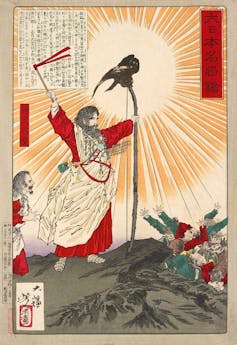Japan’s Emperor Naruhito has finally admitted that the future of the Chrysanthemum Throne is in peril. Speaking on the eve of his state visit to the UK in mid-June, Naruhito noted that the number of male heirs in the imperial family was shrinking and they were ageing.
Female members of the family, meanwhile, are forced to give up royal status when they marry: “Due to these factors, the number of members of the imperial family who can take on public duties is decreasing compared to before,” he said.
The emperor is barred by the constitution from making political statements. So while even these comments are unprecedented, he was unable to discuss the obvious solution: open up the succession to female heirs.
Public debate over Japan’s patrilineal succession system reignited soon after the enthronement of Naruhito as the 126th emperor in 2019.
When Naruhito’s father, Akihito, abdicated on grounds of declining health in 2019, it was the first such abdication in more than 200 years and there was little or no constitutional provision for the enthronement of an emperor while the previous emperor still lived.
So the government quickly passed a law to allow this. The process also sparked the renewal of debate on the male-only succession system. The specific exclusion of women as heirs and monarch was first enacted as law in 1869 in article 2 of the Meiji Constitution and upheld in the 1947 re-written constitution of Japan after the second world war.
But approval for having women on the imperial throne has continued to grow in Japan. A recent poll suggested 90% of public support for a change to the law to enable women to take the throne.
In October 2023, Japan’s prime minister, Kishida Fumio, called for discussion on the issue of male-only imperial succession and set up a group to explore the possibility of change.
But conservative members of the ruling Liberal Democrat Party continue to oppose this and block any debate about women on the throne from moving forward. They claim that the “unbroken” male lineal succession is based on an ancient tradition and is something “inherently Japanese”.
Reigning men
As a result, of 18 imperial family members, not one of the 13 women will have access to the throne.
As things stand, there are now just three living heirs to the Chrysanthemum throne. These are Naruhito’s younger brother, Prince Akishino; Akishino’s son, 17-year-old Prince Hisahito and Akihito’s 88-year-old brother (Naruhito’s uncle), Prince Masahito.
Naruhito’s 22 year-old daughter, Princess Aiko, is popular and some politicians are currently discussing reworking the 1947 succession laws to enable her to become Empress Aiko if her father dies. But if she married a commoner, she would have to renounce her royal title, just like other women in the imperial family. Even if she didn’t, she still wouldn’t be in the running to take the throne as empress.
Read more: With male imperial descendants dwindling, will Japan's leaders finally accept a female emperor?
Princess Nori, the emperor’s sister, was forced to leave the imperial household and surrender her title and status after marrying a “commoner” in 2005, as was Princess Mako in 2018. This is in spite of the fact that both the previous and current emperors’ marriages to “commoners” are viewed as indicators of their “humanity”.
Matriarchal origins
Ancient Japan was a matriarchal society, with women as leaders until the end of the seventh century when the Taika reform imported a new social system based on China’s Tang Dynasty at the end of the reign of Empress Kōgyoku. But politicians against this insist that the current male line of succession must remain unchanged.
Read more: Japan's constitutional dilemma: only men allowed on the Chrysanthemum throne
Japan’s state religion, Shinto, centres on a mythical past which links the traditions of the Emperor cult to a belief in the sun goddess, Amaterasu, from whom the first Emperor, Jimmu (660-585 BCE), is said to have descended. The myths surrounding Japan’s imperial origins are firmly rooted in matriarchal influences.

Chinese and Japanese historical sources show that women as leaders were not a rarity in ancient times. One of the best known is Queen Himiko, who unified a large part of the country into a powerful kingdom and ruled over more than 30 states during the later part of the Yayoi period, from about 180 to 248AD.
Enthroned at a time of political and social crisis, some historians believe that Himiko was a local chieftain on the island of Kyushu who is referred to in the Nihongi, (one of the earliest records of ancient Japan). Others think that she could have been mythologised from Amaterasu or other influential women during that period. The fact that their successors were more often than not, male (with the exception of Empress Genshō who followed her mother Empress Genmei directly to the throne) has fuelled the argument that tradition requires male-only succession.
During his time as prime minister from 2001 to 2006, Junichiro Koizumi did, in fact, open public debate and tried to push for changes to this legislation to allow women to succeed to the Chrysanthemum Throne. But after Princess Kiko gave birth to Hisahito in 2006, it provided a new male heir, which effectively overshadowed any discussion over the disparity in Japan between male and female imperial privilege.
While the emperor has no political role, the symbolic and cultural significance links modern Japan to a mythological past. But it’s the imperial family’s present existence which might fade into the realms of mythology if the Chrysanthemum throne runs out of boys.
Ella Tennant does not work for, consult, own shares in or receive funding from any company or organisation that would benefit from this article, and has disclosed no relevant affiliations beyond their academic appointment.
This article was originally published on The Conversation. Read the original article.







